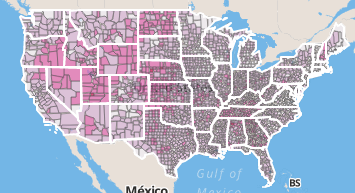The 2014 election cycle has so far been framed as an epic matchup between the tea party wing of the Republican Party and more establishment types. The establishment has thus far only lost one such beltway insider: House Majority Leader Eric Cantor (VA).
Otherwise, tea party-favored candidates have struggled to gain ground. A new analysis from the firm HaystaqDNA could explain why: county-by-county tallying of tea party support reveals that its strongholds may be in the West rather than in key southern states where candidates have mounted serious incumbent challenges.
HaystaqDNA’s findings show that the states with the highest tea party favorability scores are not necessarily ones with elections that will decide control of the Senate in 2014. Of the seven Democratic Senate seats in RealClearPolitics’s tossup category, only one, in Colorado, has counties with tea party favorability scores in the 50 and higher range (a score of 100 is the maximum). The rest are at the 35 to 50 range. Colorado’s GOP candidate for Senate, Rep. Cory Gardner, is not considered a tea party favorite also.
Moreover, of the two other states that fall under RCP’s tossup category, Georgia and Kentucky, neither state has a county going above the 50-65 point favorability range. Both states, as it happens, have passed up tea party candidates and nominated Republican Senate candidates that are considered more establishment. Kentucky is especially important because tea party challenger Matt Bevin lost badly to Senate Minority Leader Mitch McConnell in the Republican primary for Senate.
One could say New Hampshire, where former Sen. Scott Brown (R-MA) is running to replace Sen. Jeanne Shaheen (D-NH) is an exception. But that race is still considered favorable to Democrats and Brown has trailed behind Shaheen. Brown, also, is not considered a tea party candidate.
Instead, the states with counties where tea party favorability is highest are Alabama, Utah, and Nebraska. In Alabama, Winston county got a score of 65.1, in Utah, Daggett and Piute counties got scores of 65.6 and 66.6 respectfully, and in Nebraska, Arthur and Blaine counties got scores of 66.9 and 66.
Hover your cursor over a county to see favorability by county:
Here’s how HaystaqDNA compiled the data for the model: First,12,636 voters in eight states (Alabama, California, Iowa, Michigan, Mississippi, New Jersey, New Mexico, and South Dakota) were surveyed. Then those results were combined with 724 other data points like census demographics and turnout history. The surveys were conducted through IVR phone calls earlier this year. The model was built on two-thirds of the survey results. The remaining third was used as a hold-out sample. The model’s predictions were validated by comparing the actual responses against the hold-out sample.
A second validation survey was also conducted on July 8th among 5,829 voters in Alaska, Alabama, Arkansas, California, Colorado, Connecticut, Washington D.C., Delaware, Florida, Iowa, Idaho, Illinois, Kansas, Massachusetts, Michigan, Missouri, Mississippi, North Carolina, New Mexico, Nevada, Ohio, Oklahoma, Rhode Island, South Carolina, South Dakota, Texas, Utah, Virginia, Washington, Wisconsin, and West Virginia. Overall favorability in that survey was unchanged from the findings of the original survey.
Some other key findings:
• 39 percent of total respondents in the survey had a somewhat or strongly favorable opinion of the tea party.
• 61 percent had a neutral, somewhat unfavorable, or strongly unfavorable opinion of the tea party.
• Among those who said they had a strong opinion of the tea party one way or another, 60 percent said they had a unfavorable opinion while 40 percent said they had a favorable opinion.







Tea Party favorability weaker among people who don’t hang up on robocalls on their landlines.
I am confused. Was this ALL voters or just Republicans? If it’s all voters, then Michelle Nunn has NO chance in Georgia. If it’s Republicans, then she has a good chance. I suspect this was a survey of Republicans, but from the story I can’t be certain.
Yeah, nobody likes to talk about this, but polls were actually skewed toward Republicans in 2012 once the final results came in. An extra blow to the intellectually handicapped teatards.
Wow, VA really hates the Tea Party!
Those teabagger loving counties in eastern Colorado are just about the most shitbag, desolate pissant fuckholes you’ll ever encounter.
It’s no wonder the teabaggers are popular there; you’d have to be a resentful stupid fuck to take up residence in such a barren wasted place.
It’s also interesting that the most teabagger-loving parts of America are by and large populated by rural white trash dependent upon government aid of one kind or another.
Parasites.